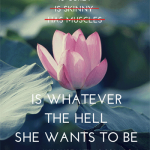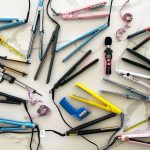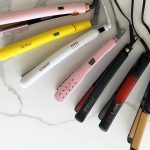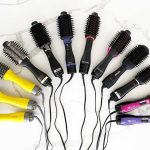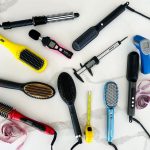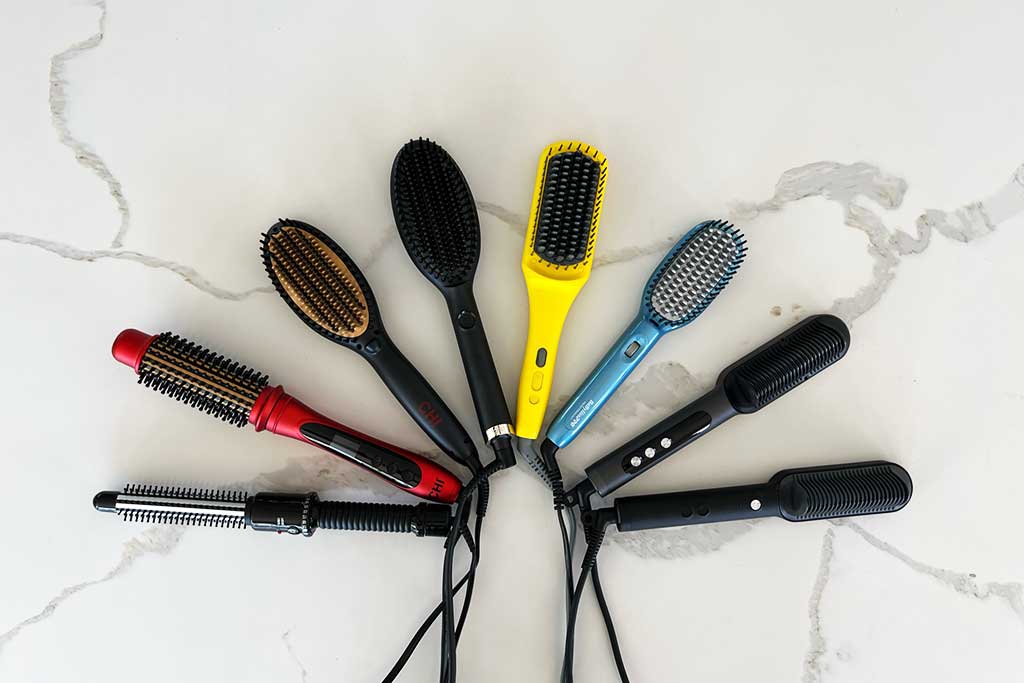
Looking for an easier way to style your hair? A straightening brush could be the perfect solution!
If you are searching for a quicker and easier way to style your hair, a straightening brush might be just what you need!
Unlike flat irons, which need careful sectioning and precise moves, straightening brushes are simple to use. Just brush your hair, and you’ll get smooth results in no time.
Straightening brushes give a nice, natural finish, but they won’t make your hair completely straight like a flat iron. If you want a softer look with a bit of movement, a straightening brush is a great choice. It helps you achieve frizz-free hair with little effort, making it ideal for everyday styling.
What is A Hair Straightening Brush?
A hair straightening brush has the shape of an ordinary hair brush. But instead of bristles, it has heated prongs. Plus, the pad of the brush heats up, making it work like a flat iron.
So, you can think of hair straightening brushes as a flat iron and a brush in one, which means they effectively detangle your hair while straightening it.
Be sure to use it on completely dry hair, as it differs from hot air brushes in that regard.
Is Hair Straightening Brush a Good Choice? For Whom and Why?
We all want a fast-styling session without damaging our hair, right? Here is the tool that will save the day for you if speed and efficiency matter more to you than perfect results.
A straightening brush is a great alternative to a flat iron, in case you are not interested in super straight hair. Because as much as it works well for removing curls and frizz, your hair will retain its body and movement for a more natural look.
That being said, a straightening brush is a much more gentle hot tool compared to a flat iron that presses your hair between two scorching hot plates.
8 Most Important Factors to Consider
If you don’t have experience with hair straightening tools, you may be confused with all those features mentioned in product descriptions and reviews.
We are here to clear that up, so take a look at the factors worth considering when choosing a hairbrush straightener.
1. Shape
Shape of the straightening brush is the first thing you need to consider before making your decision.
There are typically 3 types to choose from; paddle brush, round brush and comb.
Even though most straightening brushes come in paddle shape, it’s important to consider the other options for your hair type and the specific style you’re aiming for.
a) Paddle Brush
Best For: Fast styling, long hair
Paddle brushes are best for fast and effective styling, especially for long hair. They can cover a large section of your hair and detangle knots with ease. Drybar The Brush Crush and ghd glide are great examples for what a good paddle brush can achieve.
b) Round Brush
Best For: Wavy and curly hair, versatile styling
This option offers a much greater grip than paddle brushes, making it desirable for curly hair that requires more tension to straighten. Round brushes should be your go-to for a more versatile styling option, as they can curl your hair as well. Conair Instant Heat Styling Brush is a great budget option for only 20$.
c) Comb
Best For: Short hair, sleek results
This shape resembles a comb and provides the greatest grip. It’s the best option for shorter hair styles as it can come very close to the roots and provide the sleekest results. It has the capacity to straighten the hair the most especially for pixie and bob cuts. For longer hair on the other hand, it’s not the fastest as it can’t cover a large area with its small design. It also is not the best detangler with unruly hair.
2. Material
Mainly there are 2 types of straightening brushes you can find in the market:
a) Ceramic
Typically, straightening brushes come with a ceramic plate, but some brands take the game further by infusing the ceramic plates with tourmaline.
So, what’s the difference?
Ceramic plate is the most popular material amongst all hair straighteners and for good reason. It evenly distributes heat. This means neither hot spots that can damage your hair nor cold spots that result in needing to go over the same section more than once. Ceramic is best if you have fine, thin, or damaged hair. Ghd Glide is an ideal option for ceramic-plated brushes.
If your hair is prone to frizz, tourmaline-infused ceramic is a great option. Tourmaline is a crystal that produces more negative ions than ceramic, which helps to close the cuticle and seal in moisture. This makes it a weapon against frizzy hair. CHI Tourmaline Ceramic is worth checking out if you’re opting for frizz-free results.
b) Titanium
If you have thicker, harder-to-straighten hair, titanium is a good option. Titanium is a light metal, which means a less heavy tool. This also means it heats up faster and transfers the heat to your hair more quickly. Titanium plates are also recommended for long hair as they can recover heat faster than ceramic plates.
3. Bristles
Bristles of straightening brushes work differently than other hair tools. First of all, they usually come with two types; detangler bristles and heated bristles.
a) Heated Bristles
These bristles actually heat up and bring an extra quality to the straightening session. They are inside the area of the heated plate and are too hot to touch. It’s important to mention that while the paddle and comb shaped brushes have heated bristles, barrel shaped brushes only have detangler bristles and the heat only comes from their barrel plate.
b) Detangler Bristles
These bristles aren’t heated and they provide the detangling throughout the session. As much as they are called detanglers, these bristles are harder than the bristles of most hair tools and if they’re too dense, they may not provide the smoothest detangling. The bristles that are outside the heated plate are always detangler bristles and they’re safe to touch as they font get hot.
4. Maximum Heat Level
We all know that heat is essential to straighten your hair. What’s important here is to make sure that your brush can deliver the amount of heat your hair requires.
Maximum heat levels can vary, but they usually go from 350°F to 450°F. If you have thick and strong hair that is hard to control, you may want to go with the units that offer up to 450°F of heat. On the other hand, if your hair is of average length and strength, a lower maximum heat limit should do the trick.
Drybar the brush crush has temperature settings of minimum 200°F and maximum 450°F, which are the highest and lowest settings available in the market.
Here is the basic overview of suitability
Density – If your strands are saturated, you will need high temperatures to tame it.
Thickness – If you can feel your follicles between your forefinger and thumb, you will need a heat over 400°F to straighten them. But if your hair is thin, you should keep the temperature under 350°F to avoid hair damage.
Sensitivity – while it’s usually true that thin hair that is not dense is more sensitive than dense and thick hair, it doesn’t have to be the case. You know the sensitivity of your hair the best. The general rule is, the more sensitive the follicles, the less heat you should apply to them.
5. Adjustable Temperature
It is not only about the maximum heat level, but the ability to choose the right temperature for your hair. Many manufacturers provide “multiple heat settings”. Thanks to that, you can pick the desired heat level based on your hair type. Revlon Salon One-Step is a perfect example of what variable heat settings can provide. This brush has 10 temperature settings, one of the best we’ve seen on a hair tool. It varies from 250°F to 430°F, which is pretty precise for a styling brush. This means that you can regulate the heat for your hair type and avoid damaging your strands. The length of the hair doesn’t directly affect the temperature because you can find long and sensitive hair and short hair that is quite strong.
6. Handle
A well-designed handle should be lightweight, fit comfortably in your hand and be non-slippery. All these are simply factors that should minimize fatigue. It also needs to remain cool to the touch. Some brands even offer heat-protectant gloves with the tool but in our opinion, you should be able to work comfortably without it.
7. Auto Shut-Off
Nobody likes to start their day with a fire alarm, so it’s important to make sure your straightening brush has an auto shut-off feature. This feature automatically turns off the device after a certain amount of time, usually between 30 and 60 minutes. This is a great safety feature as it prevents the device from overheating or catching fire as well as prevents energy waste and prolongs the life of the tool.
8. Size And Weight
The weight and size it’s not only important for a comfortable session, but it’s also crucial to consider if you want to travel.
Another good rule of thumb is to pick something lightweight, as this will make it easier to maneuver and style your hair.
9. Price
You will notice that the prices vary a lot when it comes to straightening brushes. There are many options out there from budget-friendly models to high-end luxury tools. Try to not settle for something cheap for the sake of saving money because this could end up costing you more in the long run. Look for a brush that offer all the features you need and protect your hair.
Revlon Salon One-Step with a price of 40$ is a great budget-friendly and efficient option that will satisfy your needs without burning your pocket.
What You Should Keep In Mind
Daily Use
A good hair straightening brush that is convenient for everyday use should be gentle on the hair, which means it shouldn’t get too hot.
It should also do a great job detangling your hair, since you probably don’t want to spend hours in front of the mirror every day. Easy detangling is usually achieved by the combination of high-density tongs.
Plus, it should be good quality so it can endure being used daily.
So, you will probably prioritize speed and durability over design. Some of our favorites include Drybar The Brush Crush and CHI, which both thick all these boxes.
Budget
Some people only use their hair tools every once in a while, or simply they don’t want to spend a fortune on their straightening brush.
The good news is that you can get a good quality hair straightening brush for as low as 40 dollars. Revlon Hair Straightening Brush, for example, offers a decent session for this price. It’s true that budget models aren’t as durable and feature rich, but they still provide a decent session.
Performance
Performance-oriented straightening brushes generally focus on quality, long-lasting material. They also have high heat levels that go up to 450°F, as well as speedy warm-up time, for a fast styling session. Brushes in this category include the Ghd Glide, which impressed us with its strong material that stayed as new after years of use.
